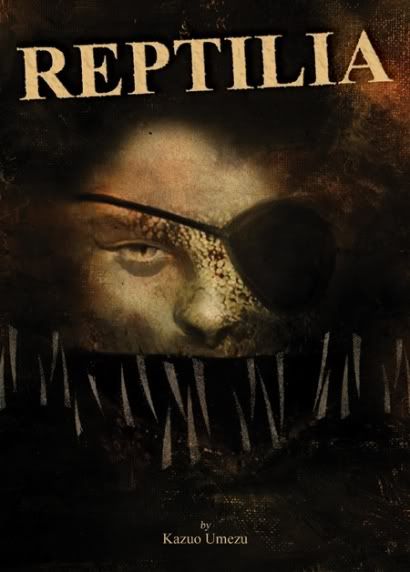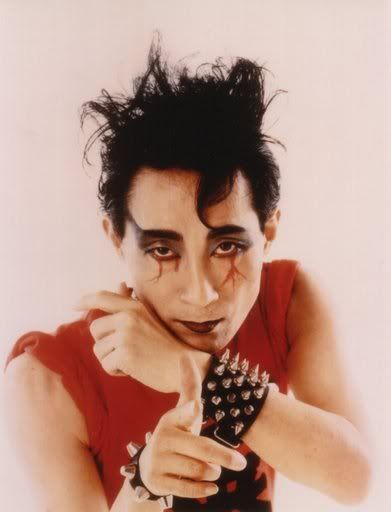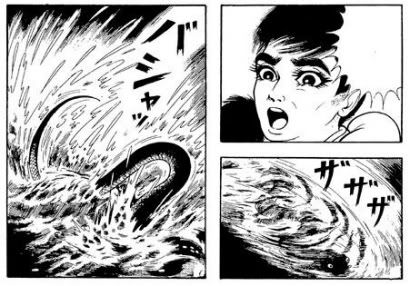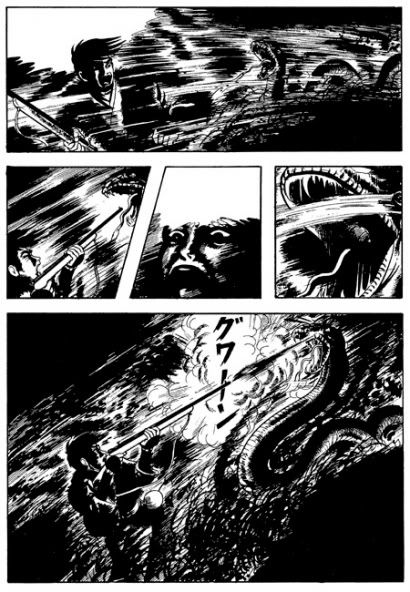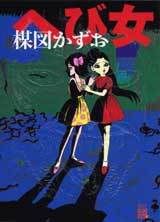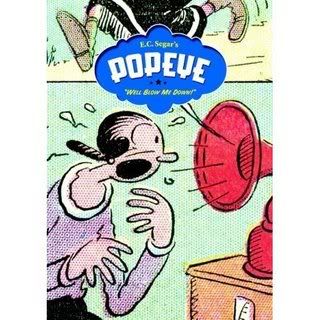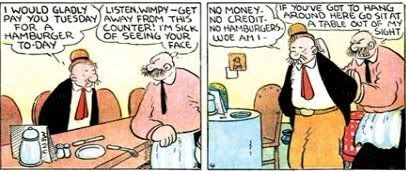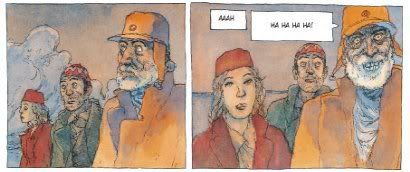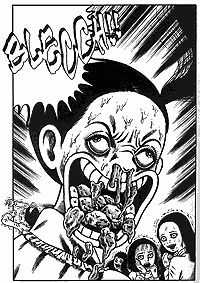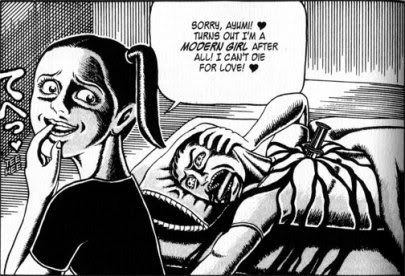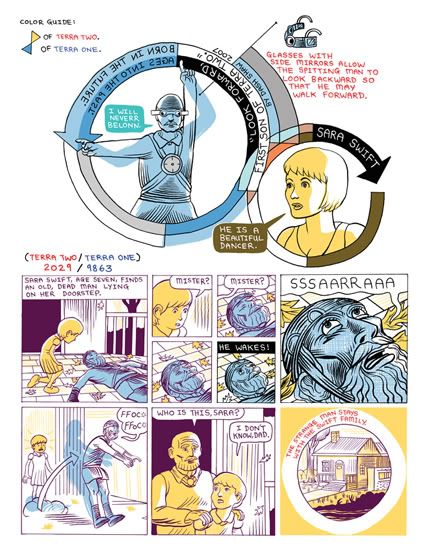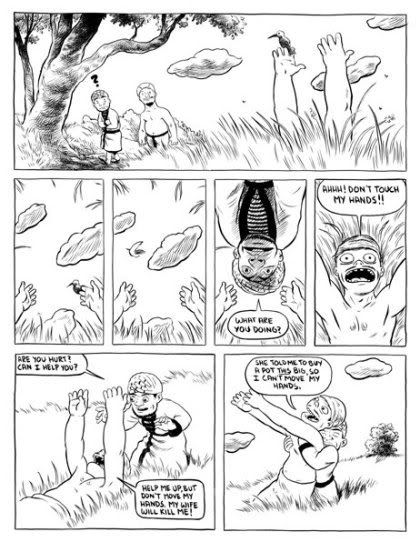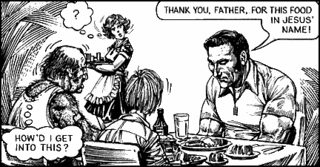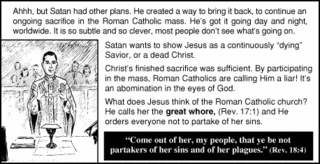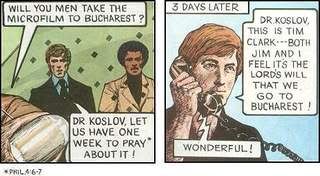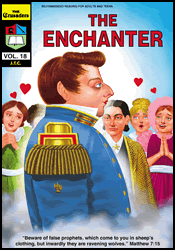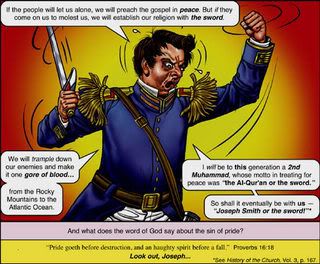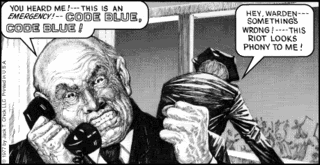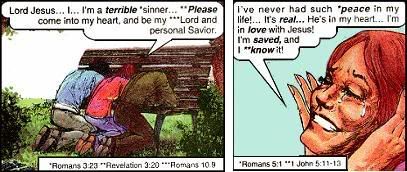Every New Top Ten List is Another Step Toward the Grave
And the only possible way to deal with it is to make a list.
The usual caveats apply. I'm only counting works that were released or completed or published in English for the first time in 2007. It sure makes life easier not having to rank Our Year in the Golden Age of Reprints too; my personal fave on that front was the wonderfully constructed George Herriman daily comics bonanza Krazy & Ignatz: The Kat Who Walked in Beauty, but many other fine things were made available.
I realize other, very worthy books might get set aside with this approach. Hands down one of the best comics I read all year was Olivier Schrauwen's outstanding My Boy, a near-brilliant homage/satire that effortlessly evokes the chromatic dawn of American newspaper comics, but it was totally not in any way a 2007 book, being an English-language import from Belgium. Good thing I have a lengthy introduction to equivocate with, eh? I mean, don't let my having read the 1995 edition of Frank Santoro's Storeyville stop you from getting the dandy new hardcover version from PictureBox. It's a good comic. So's T. Edward Bak's Service Industry, now an oversized book from Bodega Distribution.
And while I'm at it, don't see this (or any year's end list) as a finite resource for what was 'good,' with the remainder being swept off into the ashbin of mediocrity. I am always correct, even when I misspell your name or my own, but there were more than 10 (14? have I wiggled that far?) good comics released this year.
The absence of Exit Wounds from this list doesn't make the book any less a calm meditation on separation, and the lack of Alice in Sunderland shouldn't dim its thundering ambition. Don't overlook those two fine First Second books from Gipi, Garage Band and Notes for a War Story. Or Tom Kaczynski's Cartoon Dialectics. Or Andy Hartzell's Fox Bunny Funny. Or the good established pamphlet series like B.P.R.D. and The Punisher MAX. Or the good new pamphlet projects like Kyle Baker's Special Forces. Or the continuing manga drive of The Drifting Classroom.
Or the things I haven't read yet. I'd like to have found a copy of Jirō Taniguchi's The Ice Wanderer and Other Stories. I'd like to have gotten to the newer volumes of Tezuka's Phoenix. I'd like a baby brother made of emeralds and a horse that pisses gasoline. Oh well. Let's raise our glasses. You up? Up?
LIST OF THING:
#10. Mushishi Vol. 2: Good old #10 spot, home of the odd work that still hit me where it counted. Last year we had the thrillingly addled Seven Soldiers #1, and tonight we've got the sophomore volume of a series that has handsomely failed to pierce the consciousness of any 2007 readership, no matter how expanded the room has gotten for manga. But this Del Rey release of Yuki Urushibara's beloved-in-Japan stories -- following the experiences of a wandering doctor-detective who's so close to the mushi, the innate, primal stuff of life and perception, that he's as much a magician as a man of the wild -- provided the year's best argument for short-form pop comics as vessels for striking allegory and mythic revision. Top honors go to the tale of a girl infected with living writing, Urushibara's concept swirling into a grander message of counterarratives pacifying the violent writ of history. Go to your local chain bookstore, wipe the cobwebs off, and enjoy. Short review here.
#9. George Sprott (1894-1975): A serial that began in 2006; one of those New York Times comics you can download for free. On one hand, it's Seth doing his Seth thing, lingering melancholically on the passing of a older, better era. But this is a consummate expression of the artist's passion, cannily adapting the 'documentary' pep of 2005's Wimbledon Green to the serial format, and exploiting each week's large spread of tiny, uniform-hued panels as a new facet of the flawed gemstone life of the titular old-time local television host and older-time boyish adventurer. Included are the death of a man, the death of his times, the passing of personal creation into collectable items, and the ways we are born anew inside each person we meet. Richly observed, warmly characterized, beautifully drafted; the best of this year's right proper literary comics crop.
#8. House: And here's the best kick to the throat of the last 12 months. Josh Simmons' wordless horror comic, a Fantagraphics production, makes keen use of the form in slowly compacting the blinding white, wide-open world of teenage exploration and nervous romance into a diabolical black coil of hopelessness and slow, lonely doom. Like the parade of life! Good quick clever nasty shit, and indicative of a growing skill in pure comics and pure visuals. My review.
#7. Powr Mastrs Vol. 1 (of 6): PictureBox is no stranger to this site's 12/31 lists, having first turned up in 2005, but this seems to have been the year the publisher broke through to the wider discussion as a force in high-end comics that seem so utterly beyond anxieties of genre and visual tradition that you'd swear a paradigm was shifting. Riding high was this longform comics debut by C.F., a sprawling act of fantasy worldbuilding in delicate, often disarmingly elegant pencil drawings, 'inked' via photocopier, and dotted with winsomely suggestive conversation and boldly surreal events. It sure sounds clashy as a paragraph, but it hangs together with visionary ease as a comic. I can't wait to see if it holds up as the story goes on. Review.
#6. The Blot: Looking at this self-published marvel by Tom Neely, you can tell it's a labor of love. And I don't just mean the sky-high production values, comparable to those of any deluxe comics publisher today; Neely's saga of a man pursued by a devouring, inspiring, live-giving, eye-popping glob of ink rings with a desire to hash out this business of creation in iconic form on every page. Wild, funny, gross and resigned, it all but burns you with cartoon force; you won't believe it's this guy's first longform comic. I talk here.
#5. New Engineering: As for this one, well... you may not believe that it's even real. There truly is nothing else in the world like Yuichi Yokoyama's comics - it's like an adaptation of Naruto's action tropes by Martians, exploding comics' very illusion of movement to spread indelible, sometimes unreadable battles and construction projects across pages of jutting sound effects as absurd, toylike characters go about their activities. No story, no human element, no problem. And thanks to the manga boom, I've seen it in every Borders I've been to recently. I can't say it'll appeal to everyone, but I can't deny the cracked effectiveness with which it forwards its strange aesthetic; it's been stuck in my head ever since I read it. PictureBox couldn't have picked a more fitting manga for its first license. Obligatory me link.
#4. The End #1: Do note that this is the only pamphlet-format comic on my list for this year, and even then in the oversized, jacketed Ignatz format of Coconino Press & Fantagraphics. Anders Nilsen uses this large, thin format for the best work I've seen from him, a patchwork showing of all his visual styles, dedicated to illustrating grief and personal loss through a wide range of approaches. Crucially, the comic's short length promotes an intimate, scrapbook feel, letting realist depictions of a fellow weeping snap into symbolist displays of a black thatch making a man into a maze. The implication is that no one autobiographical approach is quite enough to convey the loss of a loved one, so we must hope a multiplicity of perpective can convey the totality of the experience. The format serves as both terse and eloquent in its boundaries. I reviewed it.
#3. Town of Evening Calm, Country of Cherry Blossoms: More sadly overlooked manga, this time from ol' Last Gasp. I'll forgive you for suspecting that Fumiyo Kouno's interlocking, intergenerational suite of stories concerning the legacy of the Hiroshima bombing might be a sleepy slog through 'important' subject matter, although you're quite wrong. Oh, it does have tragic sequences of illness and death, greatly enhanced by Kouno's vulnerable character art, but it's also a sly enough work to maneuver the reader into anticipating its dramatic twists from a perspective not unlike that of the prejudiced viewpoint the book seeks to correct. The result is a vital, important work, and one that remains deeply affecting for long after the story's read. A review is hidden if you scroll down.
#2. Maggots: In my review, I described artist Brian Chippendale's approach to this work, a text from the height of the '90s Fort Thunder experience, as "seizing an instrument of capital and making it radiate with personal, spiritual vision by beating the shit out of it with drawings." It's sort of an autobiographical comic drawn on top of a Japanese book catalog, but it's also an extended study in motion, a fantasy hagiography for the artist and his friends, a flurry of rustling community from a real alternate lifestyle, a screaming contraption of less than 100% efficiency that forces the reader to view it right and left and up and down, and an anticipation of the end of a society. It took years and years to get here, but PictureBox brought it in as book, object, political act, history, comedy and probably a billion other hidden things. It's hard to put into words. But it's comics at the frantic edge of culture, storytelling and visual art, and I couldn't rip my eyes away from its manic splendor and its thrilling implications. Maybe it'll have the same effect on you.
#1. Chance in Hell: Ugh, how typical! A new graphic novel by an acknowledged master of the form, and here it is on top. But I cannot tell a lie, my friends: Gilbert Hernandez's grotty tour of three stages in a woman's life, from unspeakable slums up through the seething troubles of middle class life, really did kick my ass hard. I've been told the book can be read as a catalog of nightmares Beto may be suffering from as father of a young girl; there's somthing to that, but I was most taken by the furious command of comics at work, blasting through segments of conversations so as to float their context and juxtaposing images of safety and cruelty for maximum distress. This is a restless type of storytelling, one not content to merely depict; by the end, you're going to know, and just in time for Hernandez to pull the rug out once again. Style? Substance. Books like this make it elementary. Scroll here for more.
And so, yet another year is sent away. Looking over this list, it seems to have been a strong year for bold presses against the storytelling form of comics, with full forward momentum and refinement of idiosyncratic styles alike. Or it could just be my own attentions shifting more toward the interplay of words and pictures, and pictures and pictures.
Oh yeah! This is also the year I added pictures to this site! Who'd have thought that visuals mix well with a visual medium? Not me. So let me leave you, my e-siblings, with a picture-perfect 2007 farewell in the form of the first .jpg I find on my hard drive.
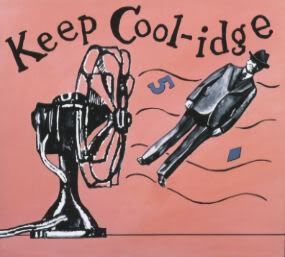
I feel closer than ever to you all. See you tomorrow.




